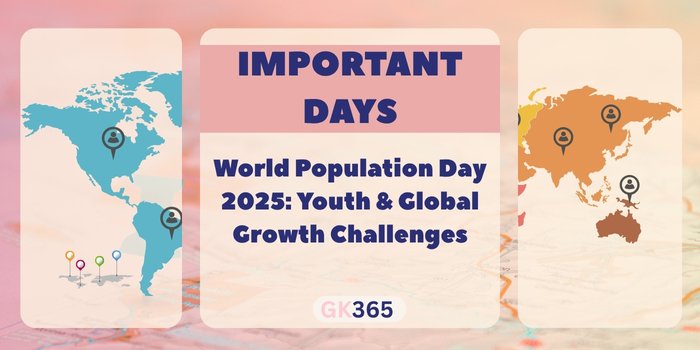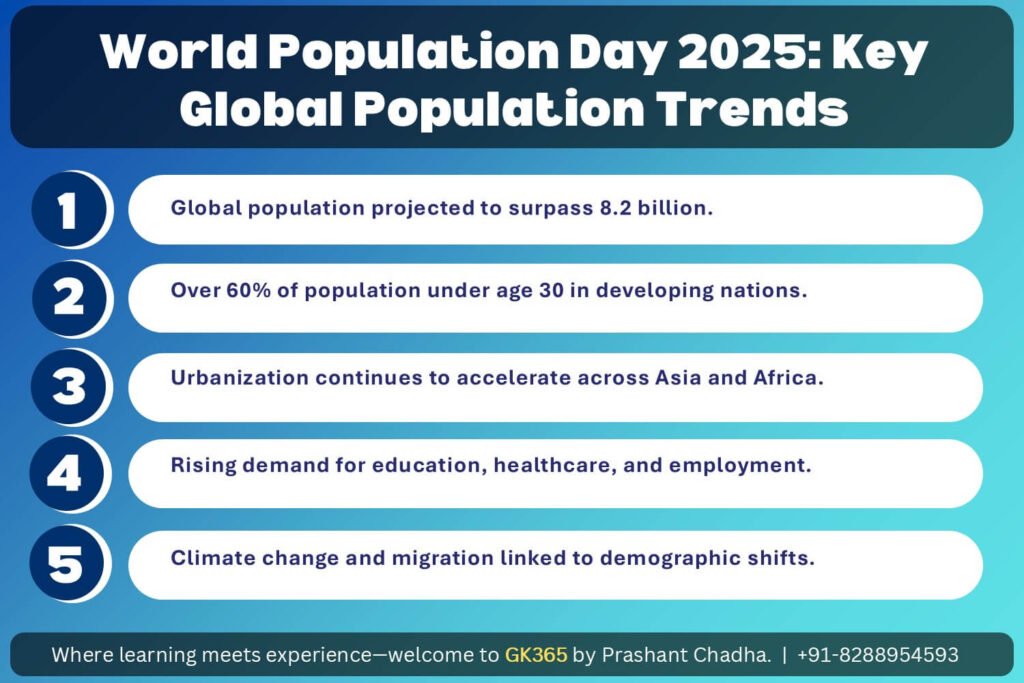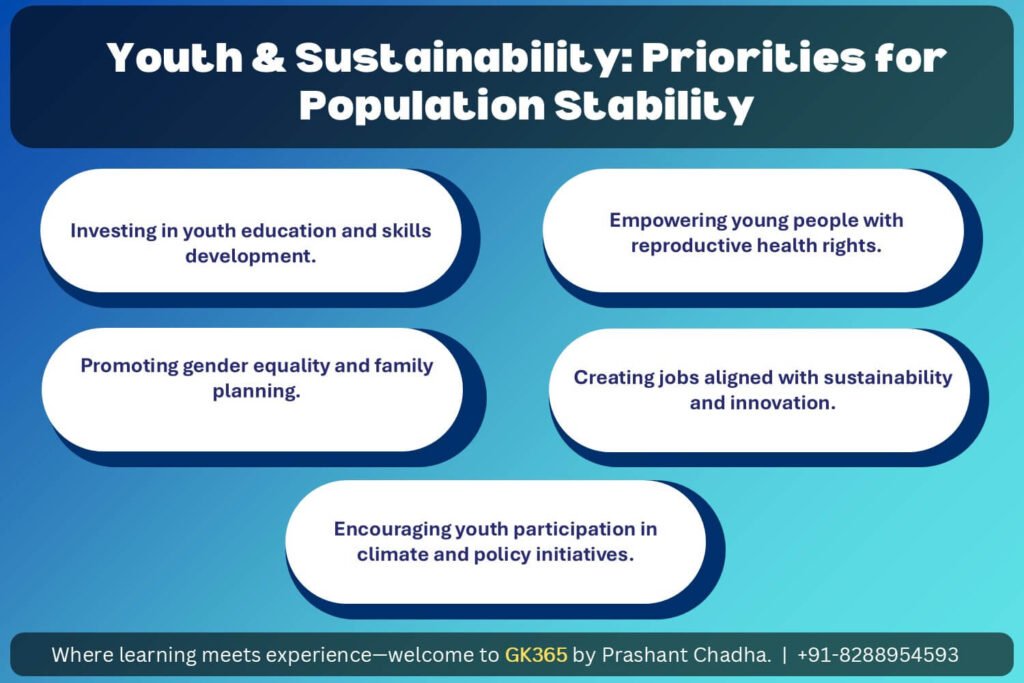Introduction: What Is World Population Day?
World Population Day is marked every year on July 11. It brings global attention to how population changes affect development, rights, and the environment. In 2025, with the world population over 8.1 billion and India now the most populous country, the focus shifts to youth, reproductive choice, and sustainable futures.
The day began in response to “Five Billion Day” on July 11, 1987. It became official in 1989 through the United Nations Development Programme (UNDP). Since then, it has called on governments and citizens to address the demands of a growing population.
📚 Table of Contents
- Historical Background and Origins
- Theme of World Population Day 2025
- Key Objectives for 2025
- Global Population Trends: 2025 and Beyond
- India Surpasses China: Demographic Implications
- Top 10 Most Populous Countries in 2025
- Population Density in 2025: Crowding Concerns
- Population in Indian States: A 2025 Snapshot
- Challenges Facing the Youth in 2025
- Why World Population Day 2025 Matters
- FAQ Section
- Useful Links
- Key Takeaways Table
Historical Background and Origins
- Founded by: United Nations Development Programme (UNDP)
- First observed: July 11, 1989
- Inspiration: “Five Billion Day” (July 11, 1987)
The observance began amid rising concerns about population pressures. Over time, it became a platform to push for health rights, gender equality, and sustainable growth. Its relevance continues as the world tackles new challenges in urbanization, youth development, and fair access to resources.
Theme of World Population Day 2025
🏷️ 2025 Theme:
“Empowering young people to create the families they want in a fair and hopeful world.”
This theme centers on the world’s largest-ever youth generation. It stresses their right to make informed choices about family planning and access key services like education, healthcare, and employment.
It supports the following global goals:
- SDG 3: Good Health and Well-being
- SDG 5: Gender Equality
- SDG 11: Sustainable Cities and Communities
Key Objectives for 2025
- 🧠 Increase awareness about how population shifts affect economies and societies
- ❤️ Promote reproductive health and rights, especially for women and youth
- 👩 Encourage women and girls to lead informed family planning
- 📈 Reinforce progress toward the Sustainable Development Goals (SDGs)
Global Population Trends: 2025 and Beyond
In 2025, the world population reaches over 8.1 billion. Demographic shifts continue to shape economic and environmental realities.
🔢 Key Milestones
- 1800s: 1 billion
- 2011: 7 billion
- 2025: 8.1 billion
- 2030: projected 8.5 billion
- 2050: projected 9.7 billion
🌆 Urbanization Trends
Since 2007, more people have lived in cities than rural areas. By 2050, two-thirds of the world will live in urban zones. This affects:
- Housing supply
- Public transport
- Sanitation and healthcare
- Environmental impact
India Surpasses China: Demographic Implications
India becomes the most populous nation in 2025.
- 🇮🇳 India: 1.46 billion
- 🇨🇳 China: 1.41 billion
This shift places India at the center of discussions around youth employment, urban policy, and social services. Nearly half of India’s population is under 25. With the right policies, this can lead to long-term economic growth.
Key priorities include:
- Expanding access to education and training
- Improving urban infrastructure
- Ensuring reproductive rights and healthcare access
Top 10 Most Populous Countries in 2025
- India – 1,463,865,525
- China – 1,416,096,094
- United States – 347,275,807
- Indonesia – 285,721,236
- Pakistan – 255,219,554
- Nigeria – 237,527,782
- Brazil – 212,812,405
- Bangladesh – 175,686,899
- Russia – 143,997,393
- Ethiopia – 135,472,051
Population Density in 2025: Crowding Concerns
Dense populations add stress to infrastructure and public services.
- Macau – 21,946 people/km²
- Monaco – 19,171
- Singapore – 8,177
- Hong Kong – 7,044
- Gibraltar – 5,901
Small nations and territories with limited land area must manage pressure through smart planning and resource efficiency.
Population in Indian States: A 2025 Snapshot
- Uttar Pradesh – 241 million
- Maharashtra – 124 million (est.)
- Bihar – 120 million (est.)
- West Bengal – 100 million (est.)
- Madhya Pradesh – 90 million (est.)
🧭 Least Populous State: Sikkim – approx. 703,000
Challenges Facing the Youth in 2025
While overall population growth slows in some areas, young people still face deep challenges.
🔍 Core Issues
- 🏚️ Job insecurity and slow wage growth
- 🏥 Gaps in healthcare and contraceptive access
- 🌍 Worries about climate change
- 🎓 Unequal access to education and technology
- ⚠️ Conflict, migration, and instability
According to UNFPA, one in five adults worldwide cannot plan their families as they would like, often because of outside limits, not personal choice.
Why World Population Day 2025 Matters
World Population Day serves a real purpose. It helps drive action and awareness on key issues.
🔑 Why It Matters
- Spotlights the link between population growth and sustainability
- Supports young people with tools and knowledge
- Pushes for gender fairness in family planning
- Encourages cities to prepare for urban shifts and ageing populations
- Keeps global focus on health, equality, and inclusive development (SDG 3, 5, and 11)
❓ FAQ Section
- Why does World Population Day 2025 matter?
It addresses how population trends affect health, gender rights, and the environment—especially as India reaches a new milestone. - Why July 11?
The date marks “Five Billion Day” in 1987, a key moment for global awareness on population issues. - What is this year’s theme?
“Empowering young people to create the families they want in a fair and hopeful world.” - Why is India’s population in focus?
India becomes the world’s most populous country, shaping conversations about education, jobs, and healthcare. - How does this day support the SDGs?
It promotes rights and sustainability, aligned with health (SDG 3), gender equality (SDG 5), and city planning (SDG 11).
🔗 Useful Links
On World Population Day 2025, help empower the next generation. Support education, access to healthcare, and youth leadership in climate and policy decisions.
👉 Join the conversation. Share ideas. Build awareness. Influence smarter, fairer population policies for the future.
🔗 Explore insights and updates at GK365.in.
Key Takeaways Table
| Category | Details |
|---|---|
| Event Name | World Population Day |
| Date Observed | July 11, annually |
| Origin | Inspired by “Five Billion Day” (July 11, 1987); officially established by UNDP in 1989 |
| Theme for 2025 | “Empowering young people to create the families they want in a fair and hopeful world” |
| Global Focus | Youth empowerment, reproductive rights, gender equality, and access to healthcare and education |
| Global Population in 2025 | Over 8.1 billion |
| India vs China | India becomes the most populous country in 2025: 🇮🇳 India – 1.46 billion🇨🇳 China – 1.41 billion |
| Urbanization Trends | By 2050, two-thirds of people will live in cities—posing challenges for housing, infrastructure, and sustainability |
| Key Global Objectives | – Promote reproductive health- Support Sustainable Development Goals (SDG 3, 5, 11)- Empower women and youth |
| Top 3 Populous Countries | 1. India (1.46B) 2. China (1.41B) 3. USA (347M) |
| Most Densely Populated Areas | Macau, Monaco, Singapore, Hong Kong, Gibraltar |
| Indian State Populations | Largest: Uttar Pradesh (241M); Smallest: Sikkim (~703K) |
| Youth Challenges in 2025 | Job insecurity, healthcare access, climate anxiety, digital divide, and migration-related instability |
| Why It Matters | Draws global attention to links between population and development—especially youth futures, urban planning, and reproductive freedom |
| Supported SDGs | SDG 3 (Health), SDG 5 (Gender Equality), SDG 11 (Sustainable Cities) |



